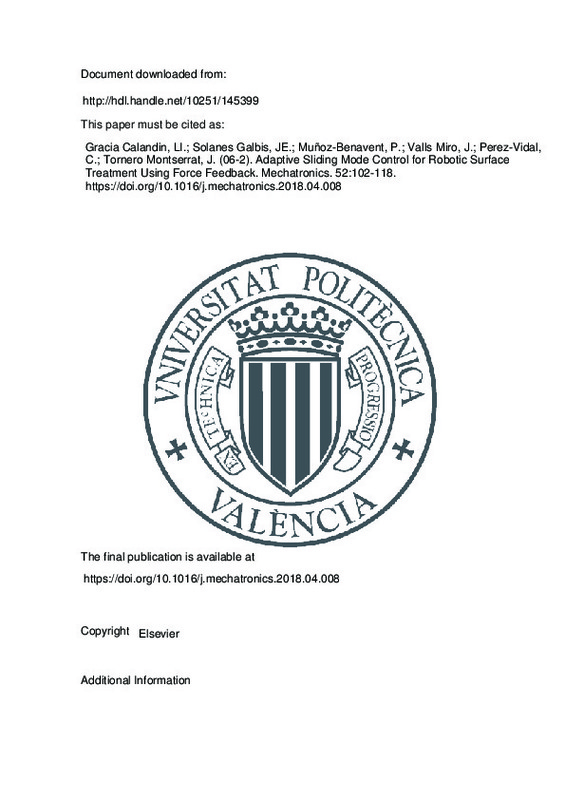JavaScript is disabled for your browser. Some features of this site may not work without it.
Buscar en RiuNet
Listar
Mi cuenta
Estadísticas
Ayuda RiuNet
Admin. UPV
Adaptive Sliding Mode Control for Robotic Surface Treatment Using Force Feedback
Mostrar el registro sencillo del ítem
Ficheros en el ítem
| dc.contributor.author | Gracia Calandin, Luis Ignacio
|
es_ES |
| dc.contributor.author | Solanes Galbis, Juan Ernesto
|
es_ES |
| dc.contributor.author | Muñoz-Benavent, Pau
|
es_ES |
| dc.contributor.author | Valls Miro, Jaime
|
es_ES |
| dc.contributor.author | Perez-Vidal, Carlos
|
es_ES |
| dc.contributor.author | Tornero Montserrat, Josep
|
es_ES |
| dc.date.accessioned | 2020-06-05T03:32:21Z | |
| dc.date.available | 2020-06-05T03:32:21Z | |
| dc.date.issued | 2018-06 | es_ES |
| dc.identifier.issn | 0957-4158 | es_ES |
| dc.identifier.uri | http://hdl.handle.net/10251/145399 | |
| dc.description.abstract | [EN] This work presents a hybrid position-force control of robots in order to apply surface treatments such as polishing, grinding, finishing, deburring, etc. The robot force control is designed using sliding mode concepts to benefit from robustness. In particular, the sliding mode force task is defined using equality constraints to attain the desired tool pressure on the surface, as well as to keep the tool orientation perpendicular to the surface. In order to deal with sudden changes in material stiffness, which are ultimately transferred to the polishing tool and can produce instability and compromise polishing performance, several adaptive switching gain laws are considered and compared. Moreover, a lower priority tracking controller is defined to follow the desired reference trajectory on the surface being polished. Hence, deviations from the reference trajectory are allowed if such deviations are required to satisfy the constraints mentioned above. Finally, a third-level task is also considered for the case of redundant robots in order to use the remaining degrees of freedom to keep the manipulator close to the home configuration with safety in mind. The main advantages of the method are increased robustness and low computational cost. The applicability and effectiveness of the proposed approach are substantiated by experimental results using a redundant 7R manipulator: the Rethink Robotics Sawyer collaborative robot. | es_ES |
| dc.description.sponsorship | This work was supported in part by the Spanish Government under the project DPI2017-87656-C2-1-R and the Generalitat Valenciana under Grants VALi + d APOSTD/2016/044 and BEST/2017/029. | es_ES |
| dc.language | Inglés | es_ES |
| dc.publisher | Elsevier | es_ES |
| dc.relation.ispartof | Mechatronics | es_ES |
| dc.rights | Reconocimiento - No comercial - Sin obra derivada (by-nc-nd) | es_ES |
| dc.subject | Force control | es_ES |
| dc.subject | Adaptive switching gain | es_ES |
| dc.subject | Polishing | es_ES |
| dc.subject | Finishing | es_ES |
| dc.subject.classification | INGENIERIA DE SISTEMAS Y AUTOMATICA | es_ES |
| dc.subject.classification | ARQUITECTURA Y TECNOLOGIA DE COMPUTADORES | es_ES |
| dc.title | Adaptive Sliding Mode Control for Robotic Surface Treatment Using Force Feedback | es_ES |
| dc.type | Artículo | es_ES |
| dc.identifier.doi | 10.1016/j.mechatronics.2018.04.008 | es_ES |
| dc.relation.projectID | info:eu-repo/grantAgreement/GVA//BEST%2F2017%2F029/ | es_ES |
| dc.relation.projectID | info:eu-repo/grantAgreement/GVA//APOSTD%2F2016%2F044/ | es_ES |
| dc.relation.projectID | info:eu-repo/grantAgreement/AEI/Plan Estatal de Investigación Científica y Técnica y de Innovación 2013-2016/DPI2017-87656-C2-1-R/ES/VISION ARTIFICIAL Y ROBOTICA COLABORATIVA EN PULIDO DE SUPERFICIES EN LA INDUSTRIA/ | es_ES |
| dc.rights.accessRights | Abierto | es_ES |
| dc.contributor.affiliation | Universitat Politècnica de València. Departamento de Ingeniería de Sistemas y Automática - Departament d'Enginyeria de Sistemes i Automàtica | es_ES |
| dc.description.bibliographicCitation | Gracia Calandin, LI.; Solanes Galbis, JE.; Muñoz-Benavent, P.; Valls Miro, J.; Perez-Vidal, C.; Tornero Montserrat, J. (2018). Adaptive Sliding Mode Control for Robotic Surface Treatment Using Force Feedback. Mechatronics. 52:102-118. https://doi.org/10.1016/j.mechatronics.2018.04.008 | es_ES |
| dc.description.accrualMethod | S | es_ES |
| dc.relation.publisherversion | https://doi.org/10.1016/j.mechatronics.2018.04.008 | es_ES |
| dc.description.upvformatpinicio | 102 | es_ES |
| dc.description.upvformatpfin | 118 | es_ES |
| dc.type.version | info:eu-repo/semantics/publishedVersion | es_ES |
| dc.description.volume | 52 | es_ES |
| dc.relation.pasarela | S\373860 | es_ES |
| dc.contributor.funder | Generalitat Valenciana | es_ES |
| dc.contributor.funder | Agencia Estatal de Investigación | es_ES |







![[Cerrado]](/themes/UPV/images/candado.png)

